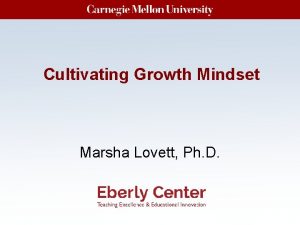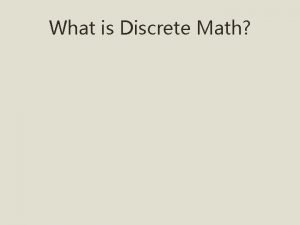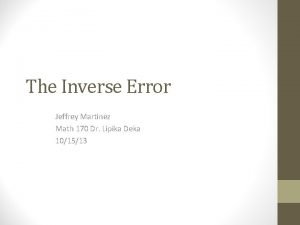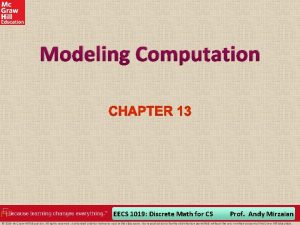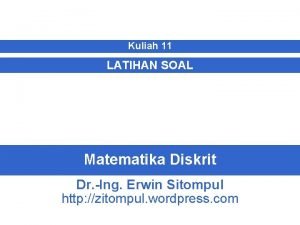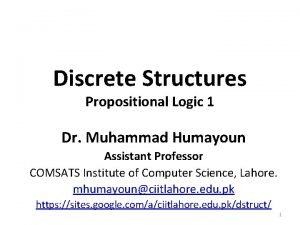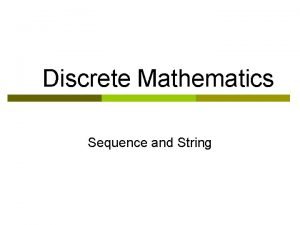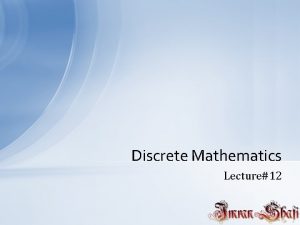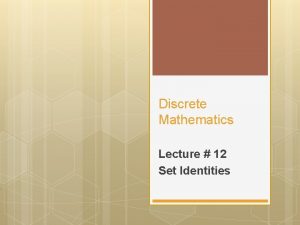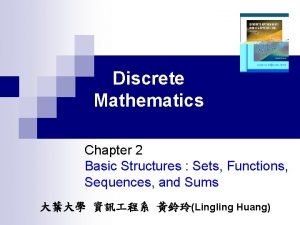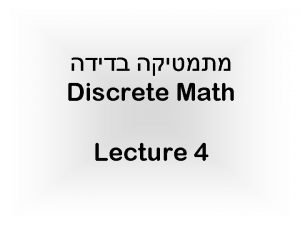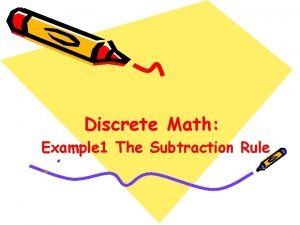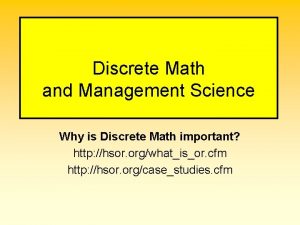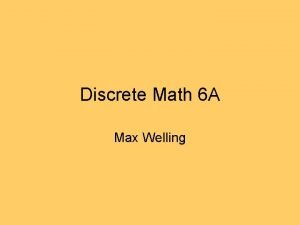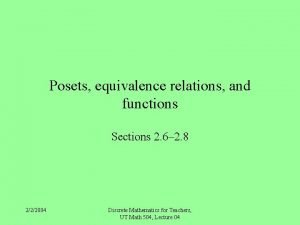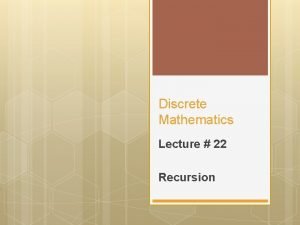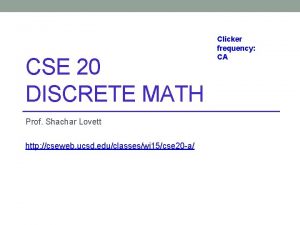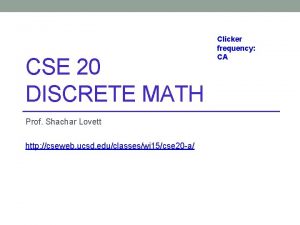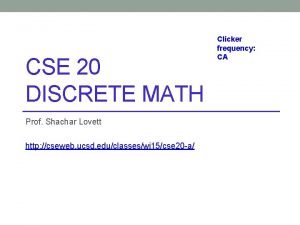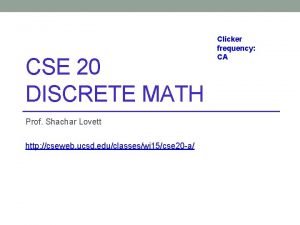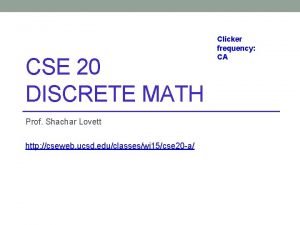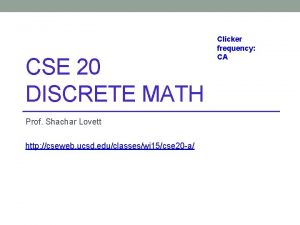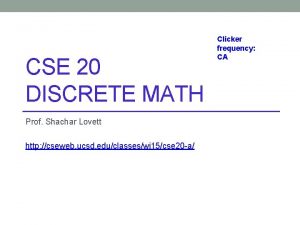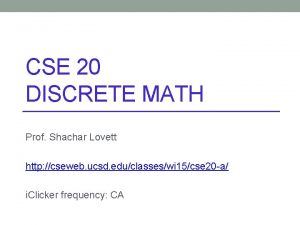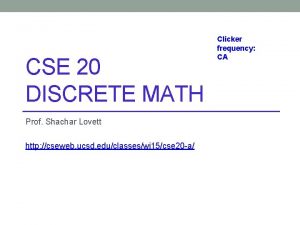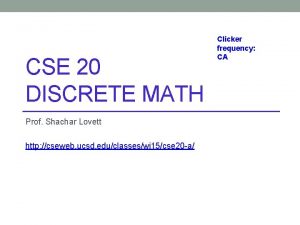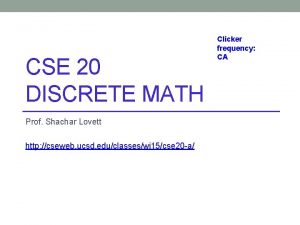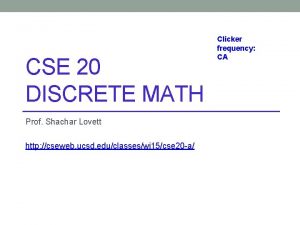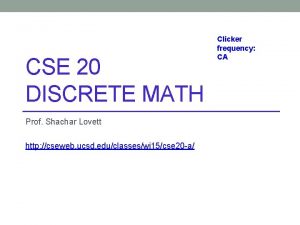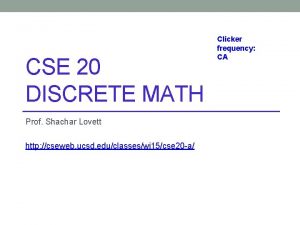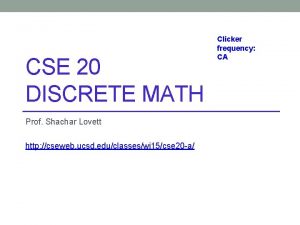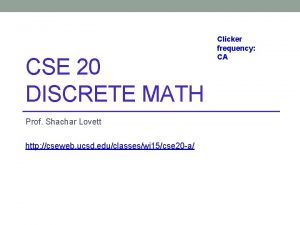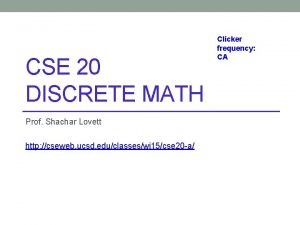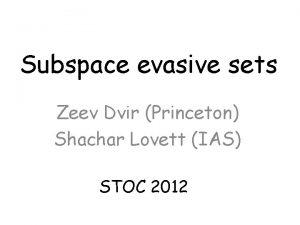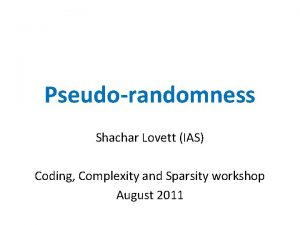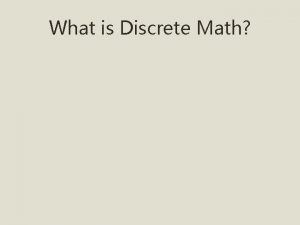CSE 20 DISCRETE MATH Prof Shachar Lovett http














![Thm. |[0, 1]| != |N| Proof by contradiction: Assume |[0, 1]| = |N|, so Thm. |[0, 1]| != |N| Proof by contradiction: Assume |[0, 1]| = |N|, so](https://slidetodoc.com/presentation_image_h2/ce0a023b278eb0eb98bd32366ba3dc43/image-15.jpg)
![Thm. |[0, 1]| != |N| Proof by contradiction: Assume |[0, 1]| = |N|, so Thm. |[0, 1]| != |N| Proof by contradiction: Assume |[0, 1]| = |N|, so](https://slidetodoc.com/presentation_image_h2/ce0a023b278eb0eb98bd32366ba3dc43/image-16.jpg)
![Thm. |[0, 1]| != |N| Proof by contradiction: Assume |[0, 1]| = |N|, so Thm. |[0, 1]| != |N| Proof by contradiction: Assume |[0, 1]| = |N|, so](https://slidetodoc.com/presentation_image_h2/ce0a023b278eb0eb98bd32366ba3dc43/image-17.jpg)
![Thm. |[0, 1]| != |N| Proof by contradiction: Assume |[0, 1]| = |N|, so Thm. |[0, 1]| != |N| Proof by contradiction: Assume |[0, 1]| = |N|, so](https://slidetodoc.com/presentation_image_h2/ce0a023b278eb0eb98bd32366ba3dc43/image-18.jpg)






- Slides: 24

CSE 20 DISCRETE MATH Prof. Shachar Lovett http: //cseweb. ucsd. edu/classes/wi 15/cse 20 -a/ Clicker frequency: CA

Todays topics • Countably infinitely large sets • Uncountable sets • “To infinity, and beyond!” (really, we’re going to go beyond infinity)

Set Theory and Sizes of Sets • How can we say that two sets are the same size? • Easy for finite sets (count them)--what about infinite sets? • Georg Cantor (1845 -1918), who invented Set Theory, proposed a way of comparing the sizes of two sets that does not involve counting how many things are in each • Works for both finite and infinite • SET SIZE EQUALITY: • Two sets are the same size if there is a bijective (one-to-one and onto) function mapping from one to the other • Intuition: neither set has any element “left over” in the mapping

one-to-one and onto Natural numbers 1 2 3 4 … f is: a) b) c) d) one-to-one onto Bijective (both (a) and (b)) Neither f a aa aaaa … Sequences of a’s

Can you make a function that maps from the domain Natural Numbers, to the co-domain Positive Evens? Natural numbers 1 2 3 4 … 2 4 6 8 … A. Yes and my function is bijective B. Yes and my function is not bijective C. No (explain why not) Positive evens

Can you make a function that maps from the domain Natural Numbers, to the co-domain Positive Evens? Natural numbers 1 2 3 4 … f f(x)=2 x 2 4 6 8 … Positive evens

Can you make a function that maps from the domain Natural Numbers, to the co-domain Positive Odds? Natural numbers 1 2 3 4 … 1 3 5 7 … A. Yes and my function is bijective B. Yes and my function is not bijective C. No (explain why not) Positive odds

Can you make a function that maps from the domain Natural Numbers, to the co-domain Positive Odds? Natural numbers 1 2 3 4 … f f(x)=2 x-1 1 3 5 7 … Positive odds

Countably infinite size sets • So |N| = |Even|, even though it seems like it should be |N| = 2|Even| • Also, |N| = |Odd| • Another way of thinking about this is that two times infinity is still infinity • Does that mean that all infinite size sets are of equal size?

It gets even weirder: Rational Numbers (for simplicity we’ll do ratios of natural numbers, but the same is true for all Q) • 1/1 1/2 1/3 1/4 1/5 1/6 … 2/1 2/2 2/3 2/4 2/5 2/6 … 3/1 3/2 3/3 3/4 3/5 3/6 … 4/1 4/2 4/3 4/4 4/5 4/6 … 5/1 5/2 5/3 5/4 5/5 5/6 . . . 6/1 6/2 6/3 6/4 6/5 6/6 … … … …

It gets even weirder: Rational Numbers (for simplicity we’ll do ratios of natural numbers, but the same is true for all Q) • 1/1 1/2 1/3 1/4 1/5 1/6 2/1 2/2 2/3 2/4 2/5 2/6 3/1 3/2 3/3 3/4 3/5 3/6 4/1 4/2 4/3 4/4 4/5 4/6 5/1 5/2 5/3 5/4 5/5 5/6 6/1 6/2 6/3 6/4 6/5 6/6 … … … Is… there a bijection from … the natural … numbers to …Q+? . . . A. Yes B. No …

It gets even weirder: Rational Numbers (for simplicity we’ll do ratios of natural numbers, but the same is true for all Q) • 1/1 1 1/2 2 1/3 4 1/4 6 1/5 10 1/6 … 2/1 3 2/2 x 2/3 7 2/4 x 2/5 2/6 … 3/1 5 3/2 8 3/3 x 3/4 3/5 3/6 … 4/1 9 4/2 x 4/3 4/4 4/5 4/6 … 5/1 11 5/2 5/3 5/4 5/5 5/6 . . . 6/1 6/2 6/3 6/4 6/5 6/6 … … … …

Sizes of Infinite Sets • The number of Natural Numbers is equal to the number of positive Even Numbers, even though one is a proper subset of the other! • |N| = |E+|, not |N| = 2|E+| • The number of Rational Numbers is equal to the number of Natural Numbers • |N| = |Q+|, not |Q+| ≈ |N|2 • But it gets even weirder than that: • It might seem like Cantor’s definition of “same size” for sets is overly broad, so that any two sets of infinite size could be proven to be the “same size” • Actually, this is not so

Not all infinite sets have the same size •
![Thm 0 1 N Proof by contradiction Assume 0 1 N so Thm. |[0, 1]| != |N| Proof by contradiction: Assume |[0, 1]| = |N|, so](https://slidetodoc.com/presentation_image_h2/ce0a023b278eb0eb98bd32366ba3dc43/image-15.jpg)
Thm. |[0, 1]| != |N| Proof by contradiction: Assume |[0, 1]| = |N|, so a bijective function f exists between N and [0, 1]. Natural numbers 1 2 3 4 … f ? ? ? z ? … Real numbers in [0, 1]
![Thm 0 1 N Proof by contradiction Assume 0 1 N so Thm. |[0, 1]| != |N| Proof by contradiction: Assume |[0, 1]| = |N|, so](https://slidetodoc.com/presentation_image_h2/ce0a023b278eb0eb98bd32366ba3dc43/image-16.jpg)
Thm. |[0, 1]| != |N| Proof by contradiction: Assume |[0, 1]| = |N|, so a bijective function f exists between N and [0, 1]. n f(n) 1 . 100000… 2 . 333333… 3 . 314159… … … What is x in this example? a). 244… b). 134… c). 031… d). 245…
![Thm 0 1 N Proof by contradiction Assume 0 1 N so Thm. |[0, 1]| != |N| Proof by contradiction: Assume |[0, 1]| = |N|, so](https://slidetodoc.com/presentation_image_h2/ce0a023b278eb0eb98bd32366ba3dc43/image-17.jpg)
Thm. |[0, 1]| != |N| Proof by contradiction: Assume |[0, 1]| = |N|, so a bijective function f exists between N and [0, 1]. n f(n) 1 . d 11 d 12 d 13 d 14… 2 . d 21 d 22 d 23 d 24… 3 . d 31 d 32 d 33 d 34… … … What is x? a). d 11 d 12 d 13… b). d 11 d 22 d 33 … c). [d 11+1] [d 22+1] [d 33+1] … d). [d 11+1] [d 21+1] [d 31+1] …
![Thm 0 1 N Proof by contradiction Assume 0 1 N so Thm. |[0, 1]| != |N| Proof by contradiction: Assume |[0, 1]| = |N|, so](https://slidetodoc.com/presentation_image_h2/ce0a023b278eb0eb98bd32366ba3dc43/image-18.jpg)
Thm. |[0, 1]| != |N| Proof by contradiction: Assume |[0, 1]| = |N|, so a bijective function f exists between N and [0, 1]. • How do we reach a contradiction? • Must show that x cannot be f(n) for any n • How do we know that x ≠ f(n) for any n? n f(n) 1 . d 11 d 12 d 13 d 14… 2 . d 21 d 22 d 23 d 24… 3 . d 31 d 32 d 33 d 34… … … a) We can’t know if x = f(n) without knowing what f is and what n is b) Because x’s nth digit differs from n‘s nth digit c) Because x’s nth digit differs from f(n)’s nth digit


Diagonalization n f(n) 1 . d 11 d 12 d 13 d 14 d 15 d 16 d 17 d 18 d 19… 2 . d 21 d 22 d 23 d 24 d 25 d 26 d 27 d 28 d 29… 3 . d 31 d 32 d 33 d 34 d 35 d 36 d 37 d 38 d 39… 4 . d 41 d 42 d 43 d 44 d 45 d 46 d 47 d 48 d 49… 5 . d 51 d 52 d 53 d 54 d 55 d 56 d 57 d 58 d 59… 6 . d 61 d 62 d 63 d 64 d 65 d 66 d 67 d 68 d 69… 7 . d 71 d 72 d 73 d 74 d 75 d 76 d 77 d 78 d 79… 8 . d 81 d 82 d 83 d 84 d 85 d 86 d 87 d 88 d 89… 9 . d 91 d 92 d 93 d 94 d 95 d 96 d 97 d 98 d 99… … … 20

Some infinities are more infinite than other infinities • Natural numbers are called countable • • • Real numbers are uncountable • • Any set that can be put in correspondence with N is called countable (ex: E+, ℚ+). Equivalently, any set whose elements can be enumerated in an (infinite) sequence a 1, a 2, a 3, … Any set for which cannot be enumerated by a sequence a 1, a 2, a 3, … is called “uncountable” But it gets even weirder… • There are more than two categories!

Some infinities are more infinite than other infinities |N| is called א 0 o |E+| = |Q| = א 0 |[0, 1]| is maybe א 1 o o Although we just proved that |N| < |[0, 1]|, and nobody has ever found a different infinity between |N| and |[0, 1]|, mathematicians haven’t proved that there are not other infinities between |N| and |[0, 1]|, making |[0, 1]| = א 2 or greater In fact, it can be proved that such theorems can never be proven… Sets exist whose size is א 0, א 1, א 2, א 3… An infinite number of aleph numbers! o An infinite number of different infinities

Famous People: Georg Cantor (1845 -1918) • His theory of set size, in particular transfinite numbers (different infinities) was so strange that many of his contemporaries hated it • Just like many CSE 20 students! • “scientific charlatan” “renegade” “corrupter of youth” • “utter nonsense” “laughable” “wrong” • “disease” • “I see it, but I don't believe it!” –Georg Cantor himself “The finest product of mathematical genius and one of the supreme achievements of purely intellectual human activity. ” –David Hilbert

Next class • Final review
 Shachar lovett
Shachar lovett Shachar tauber
Shachar tauber Mmt grades 0-5
Mmt grades 0-5 Jade lovett
Jade lovett Lovett
Lovett Marsha lovett
Marsha lovett Discrete mathematics
Discrete mathematics Inverse error
Inverse error Modeling computation discrete math
Modeling computation discrete math Absorption law logic equivalence
Absorption law logic equivalence Soal kuliah matematika
Soal kuliah matematika Discrete math propositional logic
Discrete math propositional logic Notation for sequences
Notation for sequences Define antisymmetric relation
Define antisymmetric relation Identity law in sets
Identity law in sets Onto function
Onto function Component of a mathematical system
Component of a mathematical system What does onto mean in discrete math
What does onto mean in discrete math Subtraction rule example
Subtraction rule example Euler circuit
Euler circuit Nested quantifiers
Nested quantifiers Discrete math susanna epp
Discrete math susanna epp Poset discrete math
Poset discrete math Counterexample discrete math
Counterexample discrete math Recursion discrete math
Recursion discrete math





